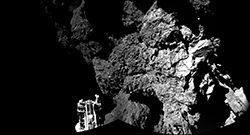Lander successfully touches down on the comet surface

An instrument developed by the Finnish Meteorological Institute (FMI) for measuring the comet's water content will be the first to touch down on the comet surface. According to the latest information, the Permittivity Probe (PP) instrument and Mass Memory developed by FMI for Philae have been functioning according to expectations.The Mass Memory processes all data collected and sends it to the orbiter, which then transmits the data to Earth.
"The successful touchdown is a huge success story, because no one has ever landed on a comet before. Because the Finnish Meteorological Institute plays a major role in the mission, this is also a major demonstration of Finnish know-how," explains Minna Palmroth, FMI Research Professor.
In addition to the PP instrument, which measures the water-ice content of the comet, the FMI has also developed the Mass Memory for Philae, which processes all the data collected and transmits it via the orbiter back to Earth.
The comet will be studied until March 2015
The first images and landing measurements were transmitted directly to the Rosetta probe via an active radio link. The images were received on Earth before the successful landing was even confirmed.
During the landing, both Rosetta's cameras and the CIVA camera on Philae took several pictures, the first of which were taken right after detachment at 10:35 a.m. Several different devices were employed during the long descent to explore the area surrounding the comet and perform calibrations.
The detailed images of the landing taken by the ROLIS camera are expected later in the night, when the Command and Data Management System (CDMS) will reconfigure its settings for functions to be performed on the surface of the comet.
"Meanwhile, all the instruments start taking their preprogrammed measurements, which goes on until the main battery runs out on November 14. Then, the solar cells on three sides and the top of Philae will begin charging the rechargeable batteries, which should hopefully keep things running until around mid-March in 2015," explains FMI Research Manager Walter Schmidt.
The results should provide more information on how much of the comet's surface is water ice at various depths, how the comet's tail is formed and how the comet interacts with solar wind. This information will help us to better understand comet development in the past and comet behaviour if one should be on a collision course with the Earth.
Further information:
Head of Unit Minna Palmroth, tel. +358 (0)40 5311 745, minna.palmroth@fmi.fi
http://ilmatieteenlaitos.fi/rosettahttp://rosetta.esa.int/
The Finnish Meteorological Institute is also following Philae developments on Twitter at twitter.com/IlmaTiede (In finnish only)
